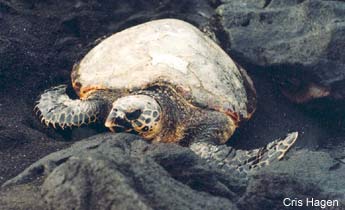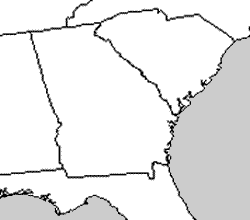Hawksbill Sea Turtle (Eretmochelys imbricata)


Photos by J.D. Willson unless otherwise noted
Description: The Hawksbill (Eretmochelys imbricata) is a small to medium-sized sea turtle. As an adult, females may reach lengths of 30 – 35 in (76-89 cm) and weights of 95-165lbs (43-75 kg), with a record length of 36+ in (90+ cm) and weight of 180 lbs (127 kg). They have typical hard shells with unique features such as large thick, overlapping (imbricate) scutes, deeply serrated carapacial margins, a beak-like mouth, and are generally brown in coloration. Older adults may lack overlapping scutes. The carapace is distinguished by 4 pairs of costal scutes with the first not touching the nuchal. Two pairs of prefrontal head plates lie between the eyes. The plastron is normally a cream to amber color which extends to the ventral surface of the head and limbs. They have two claws per flipper. Juvenile hawksbills are black to dark brown in color above and below, except for raised ridges, edges of the shell and areas around the neck and flippers, which are generally light brown in color. Juveniles have one middorsal and two plastral keels and are 1.3-2 in (3-5 cm) long at hatching. This species is sexually dimorphic. Males are generally smaller in size, more colorful and have a different shell shape than females.
Habitat: Hawksbill turtles are found in warm oceans world-wide. They can be found along Atlantic seaboard of the Southeast during the summer months, but incidence is rare. Most U.S. sightings are around Florida and Texas and they are much less common than the larger Loggerhead sea turtle (Caretta caretta). They are most commonly found in hard-bottomed and reef habitats containing coral and sponges. They also reside in shoals, lagoons of oceanic islands, and continental shelves. In general, they are found in water no deeper than 60ft. When hawksbill turtles are young, they are unable to dive into deep water, and live around masses of floating sea plants, such as sargassum.
Habits: Adults feed on fish, gastropods, echinoderms (sea urchins), and in particular, sponges. A throat lined with spines aids in digestion of sponges. Their feeding on sponges causes succession to occur in reefs by freeing up space for the settlement of new organisms. A long-lived species, the hawksbill can live past 100 years of age, although not much is known about their development in the first 20-30 years of their lives. They are nocturnal in nesting behavior and normally laying between 3-5 clutches of eggs in a nesting season. Studies have shown that hawksbills are prone to return to the beach in which they were born, although evidence of how or why this occurs is lacking. Some suggest that magnetic fields and lunar positions play a key role in this behavior. Hawksbill turtles are pan-tropical in distribution and nest on islands and mainland beaches located between the Tropic of Capricorn and the tropic of Cancer.
Conservation Status: The Hawksbill meets the 1996 IUCN Red List criteria for a Critically Endangered species, based on global population declines of more than 80% over the last 100 years.
Pertinent References:
Miller, Jeffrey D. 1997. Reproduction in Sea Turtles. pp.51-81 In: Lutz, P.L. and Musick, J.A. (Eds). The Biology of Sea Turtles. CRC Press, Boca Raton, FL.
Meylan, Anne B. and Marydele Donnelly. 1999. Status Justification for Listing the Hawksbill Turtle (Eretmochelys imbricata) as Critically Endangered on the 1996 IUCN Red List of Threatened Animals. Chelonian Conservation and Biology 3(2):200-224.
Author Account: Geoffrey Bailey, University of Georgia – edited by J.D. Willson
